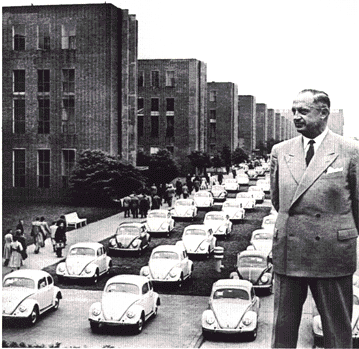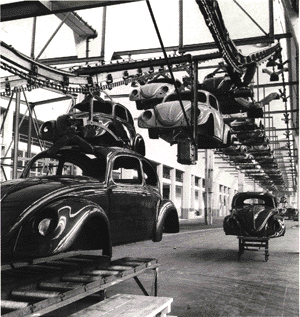| In 1949, with export sales booming, Henirich
Nordhoff, head of the Volkswagen factory, oversaw VW's decision to go after
the American dollar, seeking the most stable currency of the era for the
purchase of machine tools with which to boost production. While exports
to 6 or 7 European countries was strong, with the export Beetle, available
in more colors (green, mid brown, bordeaux red, and black) and with slightly
greater luxury, America was the great marketplace of the post war world,
and Nordhoff understood that in order for the VW to survive, it would need
to break into the American market in ways that other foreign cars were
unable.
In 1949, Nordhoff sent the Dutchman Ben Pon, a successful
salesman at marketing the Volkswagen to anti-German Holland, to New York
with a Beetle to use as a showpiece, in the interest of attracting dealers
already in the foreign car industry in America to sell the beetle.
After more than a month of trying, Pon sold the Beetle for a mere $800
to pay his hotel bill. While it was true that a few VW's had been
brought back to the states by G.I's, Nordhoff wanted to tap fully into It wasn't until Max Hoffman, already an important auto importer, agreed to purchase a few VW's in 1950 that a corporate presence for the Volkswagen in America was formed. Thus, of the 6.6 Million new cars in America in 1950, 330 of them were Volkswagens. Yet, even this small number was overblown, as the majority of dealers that purchased VW's from Hoffman did so only to increase business with Hoffman, in the hopes that for such good clients he would procure the elusive Jaguar or Porsche. Sales continued on this erratic level for the first 3 years of the decade, with 2,173 VW's registered in America by the end of 1953, a year in which VW itself exported more than 70,000 cars. Nordhoff wanted the rich American market for his people's car, and the end of 1953 marked a major change in the way that the Volkswagen would be sold to American's. To an American at the end of World War II, purchasing an import car was an expensive luxury, and a risk. While every mechanic in the country, and half of your neighbors, could work on a Chevy, who would repair a Hillman or a MG should it break down? More importantly, where, and for how much, could you get parts? Even after training yourself for the routine maintenance, who could do the body work or major repairs often needed of a car of that time? Thus, most people purchased a foreign car only if they had the money to keep one up, and lived near a mechanic to take care of it. The Foreign car was not meant for the great American pastime, the road trip, for what if it broke down 100's of miles from home, and the local mechanic had never even heard of the car? Nordhoff understood these fears, and undertook a policy to change them. Beginning in 1954, the Volkswagen Company of America (henceforth VWoA, incorporated in 1955) undertook to create a wide web of dealers and service stations, and a volume of parts, that would allow for a level of mental comfort to be achieved by the American populace. By decades end, 807 Volkswagen dealerships, all with service stations, would be operating in America. At every service station you were guaranteed to find every part your car needed, and workmen experienced in your car. Most VW shops had as many as 3 times the number of service bays and mechanics as similar American dealerships. In part this was enabled by the car itself. Unlike similar American cars, pre planned obsolescence was not in the Volkswagen vocabulary, meaning that, while occasional mechanical imporvements where consistantly made (such as the synchromesh transmission in 1952) these were constantly made with interchangability in mind, such that a 1958 clutch, improved 5 times since 1948, could still be placed in a 1948 model car. This allowed dealerships to stock parts for every VW around, without having to store the millions of parts that a similar American company would need. Also, mechanics, once trained on the VW, were likely to be able to work on any, as the majority of the technical changes were minor and well publicized. The car itself helped in other ways. It was small, and got more than twice the gas mileage of the average American car. It's tires, due to exceptional torsion bar suspension and a lighter curb weigt load, could also last twice as long, often as much as 40,000 miles. It came with many features, such as heating, standard, in a time when features were always extra on American cars. It was small enough to fit into a space half the size of most American cars, yet, designed for Germans, it could seat a man up to 6'8" tall. Most importantly, it was a joy to drive, according to many, and cost much less than American cars of the time, which were getting larger and larger, and eating up more and more gas, at the same time. The Volkswagen was thus the ideal second car, or single persons' car. For a family that already had a large American vehicle, but needed something for the son or wife to drive while the husband was at work, the Volkswagen was ideal. For the young working single or couple, low on money and without children, it was also ideal, and the widespread Volkswagen dealership system allowed for the great 50's leisure activity, the road trip. Thus, though there were only 6,000 VW's in America
in 1954, this figure jumped to 104,000 by 1958, From the start, VWoA had been headed by Will van de Kamp, a German of some business sense, but who never really understood American auto customs. After a long debate about the presence of models surrounding the VW at an upcoming auto show (wherein he once exclaimed "Girls? What for do I want girls? Engineers in white coats, ja, not girls!"), he eventually relented to girls, though girls in uniform, not evening gowns, and only after they each went through a 2 weeks training on the car so that they would be able to answer a wide variety of questions about the, should the curious consumer care to ask. By 1958, de Kamp was ready to resign, and Nordhoff replace him with Carl Hahn, a younger German, more skilled in English and more in touch with the American people. He brought with him his protégé, Helmut Schmidt, a younger, short, and self assured, who would eventually head the young advertising department at VWoA. Though the first half of the decade had been a dreary one for sales of the VW to America, by 1958 sales had picked up enough of this car, by word of mouth alone, for Detroit to take notice. VW the car had almost no advertising until 1959, and the only VW ads around were those in 1957 for the poor selling Transporter, which would develop in the American vernacular as the VW bus. However, after a sales boost, advertising for this model had slowed down, and the strong performance of VW car sales made VWoA wary of spending money on something as frivolous as advertising. At the time the VW was felt to be a car for those who didn't define themselves through their car. You might have an architect neighboror a teacher at the local school, who drove a volkswagen. It wasn't a car that the mainstream considered a real alternative, but those who chose an alternative to the mainstream often saw it as the only option. Yet, in 1958 the industry was aware that Detroit was preparing for a comeback, and that in 1960 all of the big 3 would be releasing more compact cars with which to compete with the increasingly large market share that VW was occupying, with more than 600,000 imports selling in America in 1958, and 150,000 of those VW's. Thus Hahn and Schmidt would comes to accept that advertising was soon to become vitally important to the survival of VW sales during the onslaught, even though at the time, early 1959, there was a 6 month waiting period on purchasing a VW. Ironically, however, American compact cars wear so often poorly engineered, and sacrificed so much space (often for fear of robbing their own larger car buyers) that they never truly faced a threat to the VW, but that could not have been known at the time. VW, having little ad experience in the past, made the transition from primarily word of mouth marketing to produced advertising smoothely. Studies had shown that most advertising was read by stockholders and owners seeking reaffirmation of a previous decision, which was something that most early VW buyers seldom needed, but expanding the market outside the knowledgable consumer would require this kind of presence. Schmidt was also aware that normal advertising, with mansions, women, and mountains, would not only not be affective with the market that VW tapped, but also went against the grain of the VW philosophy.With this in mind, word spread on Madison Avenue of a new automotive ad campaign on the market in late 1958. Initially frustrated with companies that could produce hundreds of ad's without a knowledge of the product, they eventually contracted the young company Doyle Dane Berbach, 80th in size for it's industry. In July 1959, the contract was signed, signally the begining of an advertising campaing the would revolutionize the industry, and in a few short years woudl bring the VW from a car for the rare few who looked seriously into car buying and into the open market of American Consumerism. By 1963, Beetle sales would reach 215,000, desptie the launch of cars like the Valiant, Falcon and the Corvair. Through the effort of Max van de Kamp, Heinrich Nordhoff, Carl Hahn, and Helmut Schmidt, VW was able to crack the shell, almost alone among imports and definately the pioneer, of the American auto market, and change not only the industry but also American culture in the process. |
 the
American market, and felt that Pon's pour showing was not the end.
Thus he himself went over later in 1949, and again managed only the sale
of one car, without any interest from foreign car dealerships.
the
American market, and felt that Pon's pour showing was not the end.
Thus he himself went over later in 1949, and again managed only the sale
of one car, without any interest from foreign car dealerships.
 and
150,000 by 1959.
and
150,000 by 1959.
